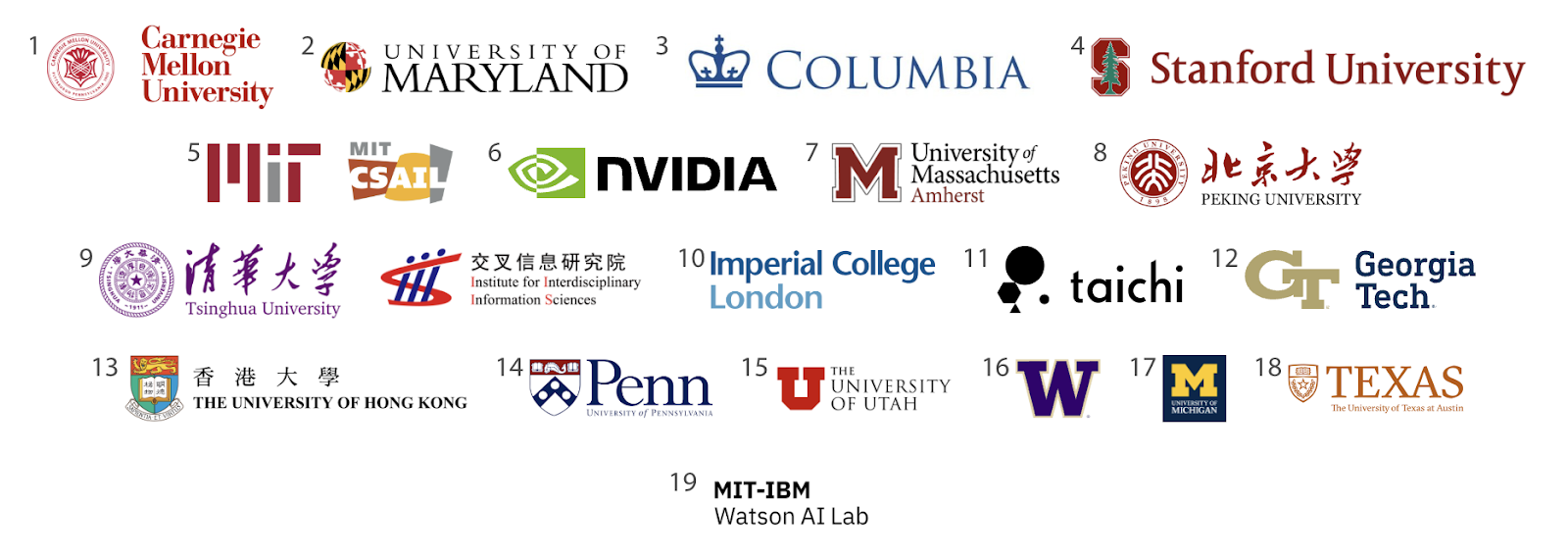Track
This December’s releases in AI video generation seem endless—after Sora and Veo 2, the spotlight has now shifted to Genesis.
Genesis is an AI physics engine capable of producing highly realistic simulations. It’s impressively fast and can generate interactive 4D worlds. Key use cases include robotics and physics experiments.
In this blog, I’ll provide an overview of Genesis, showcase a few examples, and compare it with other video generation tools like Sora. To learn how to set up Genesis, read this step-by-step guide on setting up Genesis.
What Is Genesis?
Genesis is a physics platform made for a wide range of uses, including robotics, AI that interacts with the real world, and AI that works with physical objects. Genesis is the result of a big collaboration between more than 20 research labs over two years.

Core contributors. Image source: Genesis
Unlike regular video generators, Genesis was designed specifically as a physics engine. It combines different physics tools (like rigid body, fluids, and soft materials) into one system. This makes it capable of handling various real-world simulations. We could use Genesis as a:
- Physics engine: It’s a super advanced physics simulator that can handle all kinds of materials and physical events, completely rebuilt from scratch.
- Robotics simulator: It’s lightweight, super-fast, easy to use with Python, and perfect for simulating robots.
- Rendering system: It creates realistic visuals very quickly and with great quality.
- Data generator: It can take natural language descriptions and turn them into all kinds of data.
Develop AI Applications
Compared to older simulation platforms, here are some key features of Genesis:
- Incredible speed: Genesis is extremely fast, simulating over 43 million frames per second (FPS) for a robotic arm on an RTX 4090. That’s 430,000 times faster than real-time! Genesis is the fastest physics engine in the world, up to 80 times faster than other simulators like Isaac Gym or Mujoco, without losing accuracy.
- Works everywhere: It runs on Linux, MacOS, and Windows, and supports different hardware, including CPUs, Nvidia GPUs, AMD GPUs, and Apple Metal.
- All-in-one physics system: Genesis combines many physics tools into one system, simulating rigid bodies, liquids, gases, deformable objects, and more. It can handle a variety of materials and how they interact.
- Supports all robots: Robotic arms, drones, soft robots, legged machines.. You name it, Genesis works with a wide range of objects and supports popular file types like .xml, .obj, .stl, and others.
- Python-powered: Genesis is built entirely in Python, which is simple to use and customize.
Genesis Video Examples
Genesis can simulate things like object motion, character movements, and interactions with incredible accuracy. Let’s take a look at a few examples shared by the Genesis team.
Creating 4D dynamic worlds
Genesis uses its advanced physics engine and AI tools to build detailed, realistic virtual worlds that include movement and interaction in 4 dimensions. These worlds can be used to create accurate videos, animations, and other data for simulations. It can even generate camera movements and object actions that feel natural and consistent.
Character motion
Genesis can create detailed animations for characters. For example:
A small Wukong figure sprints across a table, leaps into the air, and pauses mid-jump while the camera rotates around him before he lands.
Robotic policy generation
Genesis helps robots learn skills and perform tasks automatically in various scenarios. Here’s one example:
A robot arm heating food in a microwave
Interactive 3D scene generation
Genesis can create detailed 3D spaces, like:
A home interior with a living room, kitchen, study, and bedroom
Open-world object creation
Genesis generates realistic objects with moving parts (articulated objects) that go beyond typical pre-made assets.
Soft robot simulation
Genesis simulates soft robots or hybrids (soft exteriors with a rigid skeleton), such as:
A worm moving with muscle-like properties.
Speech, animation, and emotions
Genesis can create facial animations paired with speech, showing transitions between emotions like neutral, angry, and happy.
Getting Started With Genesis
While I’m working on a detailed coding tutorial on Genesis, which I’ll publish soon, this section will cover only the basics.
To install Genesis, run pip install genesis-world in your terminal.
You will need to make sure you have Python 3.9 or later and install PyTorch. To set it up, follow the instructions on the PyTorch website.
The Genesis documentation is a helpful resource that shows you how to use all the features of this physics simulation tool. It starts by explaining what Genesis is, why it was created, and how to set it up. Then, it walks you through basic features like creating visuals, controlling robots, and running multiple simulations at once.
You’ll also find tools for tasks like planning robot movements, working with soft robots, and using reinforcement learning to teach robots how to move. For more advanced users, the guide includes topics like handling collisions, using simulations to make adjustments, and working with drones.
Genesis vs. Sora vs. Veo 2
Let's now compare Genesis, Sora, and Veo 2 and see how they are different from each other:
Purpose and focus
- Genesis: A tool for simulating physics, designed for robotics and AI applications.
- Sora: A model that creates videos from text prompts, focusing on imaginative or realistic visuals.
- Veo 2: An advanced video generator that combines high-quality visuals with realistic physics.
Key features
- Resolution and length:
- Genesis doesn’t generate videos but focuses on physics simulation.
- Sora creates videos up to 1080p and 20 seconds long.
- Veo 2 supports up to 4K resolution and videos over 2 minutes long.
- Physics simulation:
- Genesis is excellent at fast, accurate physics simulations.
- Sora has a limited understanding of physics.
- Veo 2 models physics like fluids and object interactions.
- Visuals:
- Genesis prioritizes physical accuracy over looks.
- Sora creates hyperrealistic or imaginative visuals.
- Veo 2 delivers highly realistic videos with fewer errors compared to Sora.
- User control:
- Genesis allows detailed control over physics simulations.
- Sora uses text prompts to create videos.
- Veo 2 offers precise camera control and cinematic effects.
Strengths
- Genesis: Super-fast physics simulations, combines multiple physics tools, and is Python-based for easy use.
- Sora: Great for creative and imaginative storytelling.
- Veo 2: Best for realistic videos, strong control over scenes, and excellent handling of human movements.
Applications
- Genesis: Used in robotics, gaming, and AI research needing accurate physics.
- Sora: Perfect for creative industries like video production and entertainment.
- Veo 2: Ideal for filmmaking, content creation, and high-detail scientific videos.
|
Feature |
Genesis |
Sora |
Veo 2 |
|
Purpose |
Physics simulation for robotics, embodied AI, and physical AI |
Text-to-video generation |
High-quality video generation with physics simulation |
|
Resolution & Duration |
N/A (focuses on simulations, not video generation) |
Up to 1080p, 20-second clips |
Up to 4K resolution, 2+ minute clips |
|
Physics Simulation |
Accurate, high-speed physics simulations |
Limited physics understanding |
Advanced physics modeling, including fluids and object interactions |
|
Visual Quality |
Focuses on physical accuracy rather than visual aesthetics |
Hyperrealistic or imaginative visuals |
High realism with fewer artifacts |
|
User Control |
Highly customizable for physics simulations |
Text-to-video generation |
Precise camera control and cinematic effects |
|
Unique Strengths |
Ultra-fast simulation speeds (43 million FPS), unified physics framework, Python-based |
Excels in creative storytelling |
Superior prompt adherence, enhanced cinematography, better human movement handling |
|
Applications |
Robotics training, gaming physics, AI research requiring accurate physics modeling |
Creative industries, video production |
Filmmaking, scientific visualization, content creation |
|
Best For |
Accurate simulations and AI research |
Creative storytelling |
Realistic, high-quality video generation |
What’s Next for Genesis?
The Genesis team is working on some exciting new features that will be available soon. These include a touch sensor module that uses physics, improved simulations for rigid objects, and tiled rendering to make things run faster. They’re also adding tools for creating character and camera motions, interactive scenes, facial animations, and robot movements like walking or handling objects. Large virtual environments will also get better with a new simulation feature for more realistic results.
Some features aren’t being worked on yet. These include support for Windows rendering, a user-friendly interface, more material types for simulations, and new sensor options.
Conclusion
Genesis undoubtedly represents a substantial advancement in physics simulation and generative AI. I’ve been impressed by its speed, accuracy, and adaptability across various use cases.
While some features are still in development, the potential of this open-source tool is undeniable. I believe Genesis’s user-friendly approach and commitment to continuous improvement will make advanced physics simulation accessible to a wider audience.
Ana Rojo Echeburúa is an AI and data specialist with a PhD in Applied Mathematics. She loves turning data into actionable insights and has extensive experience leading technical teams. Ana enjoys working closely with clients to solve their business problems and create innovative AI solutions. Known for her problem-solving skills and clear communication, she is passionate about AI, especially generative AI. Ana is dedicated to continuous learning and ethical AI development, as well as simplifying complex problems and explaining technology in accessible ways.

